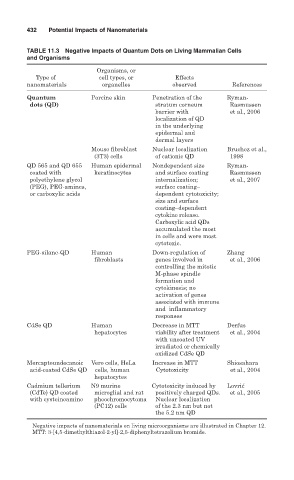Page 455 - Environmental Nanotechnology Applications and Impacts of Nanomaterials
P. 455
432 Potential Impacts of Nanomaterials
TABLE 11.3 Negative Impacts of Quantum Dots on Living Mammalian Cells
and Organisms
Organisms, or
Type of cell types, or Effects
nanomaterials organelles observed References
Quantum Porcine skin Penetration of the Ryman-
dots (QD) stratum corneum Rasmussen
barrier with et al., 2006
localization of QD
in the underlying
epidermal and
dermal layers
Mouse fibroblast Nuclear localization Bruchez et al.,
(3T3) cells of cationic QD 1998
QD 565 and QD 655 Human epidermal Nondependent size Ryman-
coated with keratinocytes and surface coating Rasmussen
polyethylene glycol internalization; et al., 2007
(PEG), PEG-amines, surface coating–
or carboxylic acids dependent cytotoxicity;
size and surface
coating–dependent
cytokine release.
Carboxylic acid QDs
accumulated the most
in cells and were most
cytotoxic.
PEG-silane-QD Human Down-regulation of Zhang
fibroblasts genes involved in et al., 2006
controlling the mitotic
M-phase spindle
formation and
cytokinesis; no
activation of genes
associated with immune
and inflammatory
responses
CdSe QD Human Decrease in MTT Derfus
hepatocytes viability after treatment et al., 2004
with uncoated UV
irradiated or chemically
oxidized CdSe QD
Mercaptoundecanoic Vero cells, HeLa Increase in MTT Shiosahara
acid-coated CdSe QD cells, human Cytotoxicity et al., 2004
hepatocytes
Cadmium tellerium N9 murine Cytotoxicity induced by Lovri ´ c
(CdTe) QD coated microglial and rat positively charged QDs. et al., 2005
with cysteineamine pheochromocytoma Nuclear localization
(PC12) cells of the 2.3 nm but not
the 5.2 nm QD
Negative impacts of nanomaterials on living microorganisms are illustrated in Chapter 12.
MTT: 3-[4,5-dimethylthiazol-2-yl]-2,5-diphenyltetrazolium bromide.

